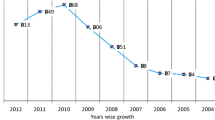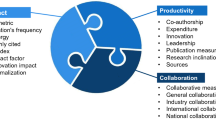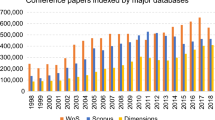Abstract
This study does a bibliometric analysis based on keywords of conference proceedings. Scientometric investigations of conference proceedings are a new and innovative, not very common approach. The studies and papers presented may be interpreted as early indicators of scientific development. The Academy of International Business (AIB) was chosen for being the leading organization for studies in international business with contributions covering a 3-year period (2006–2008). The study presents the general structure of current scholarly interest in international business studies, clusters the keywords and reflects details on the focused research areas of the papers analyzed. The bibliometric analysis indicates three clusters: the core, the semi-periphery and the periphery. The five most occurring keywords were found to be multinational enterprise, emerging markets, foreign direct investment, internationalization and knowledge management in descending order. The analyses focus on concepts building the core (in total ten keywords), the semi-periphery which is coined by performance and related topics (60 keywords) and the periphery of the studies with governance and specific facets of it (199 keywords).




Similar content being viewed by others
References
Bartels, F. L. (2005). Outsourcing markets in services: International business trends, patterns and emerging issues. Working Paper IWPS 002/05, 2005 Outsourcing Trend and Development Conference, 8–9 June 2005, China, United Nations Industrial Development Organization UNIDO.
Bilgin, F. Z., Sriram, V., & Wührer, G. A. (2004). World trade trends. In F. Z. Bilgin, V. Sriram, & G. A. Wührer (Eds.), Drivers of global business success: Lessons from emerging markets (pp. 9–25). Basingstoke: Palgrave Macmillan.
Borgatti, S. P., Everett, M. G., & Freeman, L. C. (2002). Ucinet 6.0 for windows: Software for social networks analysis. Accessed November 15, 2008 from http://www.analytictech.com/downloaduc6.htm.
Börner, K., Chen, C., & Boyack, K. W. (2003). Visualizing knowledge domains. Annual Review of Information Science and Technology, 37(1), 179–255.
Buckley, P. J. (2002). Is the international business research agenda running out of steam? Journal of International Business Studies, 33(2), 365–373.
Buckley, P. J. (2005). Introduction. In P. J. Buckley (Ed.), What is international business? (pp. 1–7). Basingstoke: Palgrave Macmillan.
Buckley, P. J., & Ghauri, P. N. (2006). Globalization, economic geography and the strategy of multinational enterprises. In P. J. Buckley (Ed.), The multinational enterprise and the globalization of knowledge (pp. 77–109). Basingstoke: Palgrave Macmillan.
Butler, L., & Visser, M. (2006). Extending citation analysis to non-source items. Scientometrics, 66(2), 327–343.
Chan, K. C., Fung, H.-G., & Leung, W. K. (2006). International business research: Trends and rankings. International Business Review, 15(4), 317–338.
Chandra, R., & Newburry, W. (1997). A cognitive map of the international business field. International Business Review, 6(4), 387–410.
Chen, C. (2003). Mapping scientific frontiers. The quest for knowledge visualization. London: Springer.
Czinkota, M. R., & Ronkainen, I. A. (2009). Trends and indications in international business: A research agenda. Management International Review, Spring.
Daniels, J. D. (2000). Emerging economies and the challenge of globalization. Advances in International Marketing, 10, 7–20.
Dawar, N., & Chattopadhyay, A. (2002). Rethinking marketing programs for emerging markets. Long Range Planning, 35(5), 457–474.
De Bakker, F. G. A., Groenewegen, P., & Den Hond, F. (2005). A bibliometric analysis of 30 years of research and theory on corporate social responsibility and corporate social performance. Business Society, 44(3), 283–317.
De Nooy, W., Mrvar, A., & Batagelj, V. (2005). Exploratory social network analysis with Pajek. Cambridge: University Press.
Ding, Y., Chowdhury, G. B., & Foo, S. (2001). Bibliometric cartography of information retrieval research by using co-word analysis. Information Processing and Management, 37(6), 817–842.
DuBois, F. L., & Reeb, D. (2000). Ranking the international business journals. Journal of International Business Studies, 31(4), 689–704.
Everitt, B. S. (2001). Cluster analysis (4th ed.). London: Sage Publications.
Fan, C. S., & Hu, Y. (2007). Foreign direct investment and indigenous technological efforts: Evidence from China. Economics Letters, 96(2), 253–258.
Gaertler, M., & Wagner, D. (2007). Visualizing large and complex networks. In G. Caldarelli & A. Vespignani (Eds.), Large scale structure and dynamics of complex networks: From information technology to finance and natural science (pp. 115–132). Singapore: World Scientific Publishing.
Glaenzel, W., Schlemmer, B., Schubert, A., & Thijs, B. (2006). Proceedings literature as additional data source for bibliometric analysis. Scientometrics, 68(2), 457–473.
Globerman, S., Shapiro, D., & Tang, Y. (2006). Foreign direct investment in emerging and transition European countries. International Finance Review, 6, 431–459.
Gugler, P. (2006). World investment report 2006. FDI from developing and transition economies: Implications for development. United Nations, New York and Geneva, 2006. International Business Review, 16(4), 528–530.
Hanneman, R. A., & Riddle, M. (2005). Introduction to social network methods. Accessed January 12, 2009 from http://faculty.ucr.edu/~hanneman/nettext/.
Kobrin, S. J. (2005). Technological determinism, globalization and the multinational firm. In P. J. Buckley (Ed.), What is international business? (pp. 38–56). Basingstoke: Palgrave Macmillan.
Krackhardt, D., & Stern, R. N. (1988). Informal networks and organizational crises: An experimental simulation. Social Psychology Quarterly, 51(2), 123–140.
Kwok, C., & Arpan, J. (2002). Internationalizing the business school: A global survey in 2000. Journal of International Business Studies, 33(3), 571–582.
Leonidou, C., & Leonidou, L. (2008). Environmental marketing strategies in the global hotel industry: Insights from an international project. Accessed January 12, 2009 from http://aib.msu.edu/events/2008/AIB2008_Proceedings.pdf.
Lévy, B. (2007). The interface between globalization, trade and development: Theoretical issues for international business studies. International Business Review, 16(5), 594–612.
Leydesdorff, L. (2001). The challenge of scientometrics. The development, measurement, and self-organization of scientific communications. Leiden, Netherlands: DSWO.
Leydesdorff, L. (2004). The university-industry knowledge relationship: Analyzing patents and the science base of technologies. Journal of the American Society for Information Science and Technology, 55(11), 991–1001.
Leydesdorff, L. (2009). How are new citation-based journal indicators adding to the bibliometric toolbox? Journal of the American Society for Information Science and Technology, 60(7), 1327–1336.
Leydesdorff, L., & Vaughan, L. (2006). Co-occurrence matrices and their applications in information science: Extending ACA to the web environment. Journal of the American Society for Information Science and Technology, 57(12), 1616–1628.
Lisée, C., Larivière, V., & Archambault, E. (2008). Conference proceedings as a source of scientific information: A bibliometric analysis. Journal of the American Society for Information Science and Technology, 59(11), 1776–1784.
McKinsey Quarterly. (2006, March). Global survey of business executives. Accessed December 19, 2008 from http://www.mckinseyquarterly.com/Strategy/Strategy_in_Practice/An_executive_take_on_the_top_business_trends__A_McKinsey_Global_Survey_1754?pagenum=2.
Noorbakhsh, F., Paloni, A., & Youssef, A. (2001). Human capital and FDI inflows to developing countries: New empirical evidence. World Development, 29(9), 1593–1610.
Noyons, E. C. M. (1999). Bibliometric mapping as a science policy and research management tool. Accessed November 25, 2008 from http://www.cwts.nl/cwts/Noyons_1999.
Peng, M. W. (2004). Identifying the big question in international business research. Journal of International Business Studies, 35(2), 99–108.
Rehn, R., & Kronman, U (2006). Bibliometric handbook for Karolinska Institutet (pp. 11–27). Stockholm: Karolinska Institutet University Library Publications.
Rokaya, M., Atlam, E., Fuketa, M., Dorji, T. C., & Aoe, J. (2008). Ranking of field association terms using co-word analysis. Information Processing & Management, 44(2), 738–755.
Roth, C., & Bourgine, P. (2006). Lattice-based dynamic and overlapping taxonomies: The case of epistemic communities. Scientometrics, 49(2), 429–447.
Rugman, A. M., & Li, J. (2007). Will China’s multinationals succeed globally or regionally? European Management Journal, 25(5), 333–343.
Small, H. (1973). Co-citation in the scientific literature: A new measure of the relationships between two documents. Journal of the American Society for Information Science, 24(4), 265–269.
Stiglitz, J. E. (2004). Globalization and growth in emerging markets. Journal of Policy Modeling, 26(4), 465–484.
Stremersch, S., & Verhoef, P. C. (2005). Globalization of authorship in the marketing discipline: Does it help or hinder the field? Marketing Science, 24(4), 585–594.
van Eck, N. J., & Waltman, L. (2007). Bibliometric mapping of the computational intelligence field. International Journal of Uncertainty, Fuzziness and Knowledge-Based Systems, 15(5), 625–645.
White, H. D., & Griffith, B. (1981). Author co-citation: A literature measure of intellectual structures. Journal of the American Society for Information Science, 32(3), 163–171.
Woo, Y.-H., Nam, D.-H., Hur, T.-S., Park, Y.-B., Huh, W., Woo, Y., et al. (2006). Automated keyword extraction using category correlation of data. In M. Gavrilova, O. Gervasi, V. Kumar, C. J. K. Tan, D. Taniar, A. Laganà, Y. Mun, & H. Choo (Eds.), Lecture notes in computer science 3981. Proceedings of the international conference of computational science and Its applications (ICCSA), Part II, 8–11 May 2006, Glasgow, UK (pp. 224–230). London: Springer.
Yamin, M., & Sinkovics, R. R. (2009). Infrastructure or foreign direct investment?: An examination of the implications of MNE strategy for economic development. Journal of World Business, 44(2), 144–157.
Yaprak, A., & Tütek, H. (2000). Globalization, the multinational firm, and emerging economies. Advances in International Marketing, 10, 1–6.
Author information
Authors and Affiliations
Corresponding author
Rights and permissions
About this article
Cite this article
Hofer, K.M., Smejkal, A.E., Bilgin, F.Z. et al. Conference proceedings as a matter of bibliometric studies: the Academy of International Business 2006–2008. Scientometrics 84, 845–862 (2010). https://doi.org/10.1007/s11192-010-0216-6
Received:
Published:
Issue Date:
DOI: https://doi.org/10.1007/s11192-010-0216-6
Keywords
- Conference proceedings
- International business
- Methodology
- Scientometrics
- Content analysis
- Theory development




